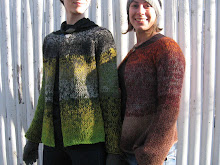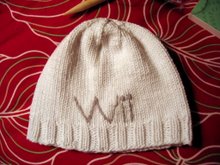February 2011: I start swatching for The Try-Works. I wanted the garment, whatever it was (at this point I wasn't sure if it would be a sweater or a shawl) to be as near to black as possible without losing the definition of the cables. Briar Rose Fibers has just those colors.

When I ready Moby-Dick in my college American Literature class, we discussed this chapter from several perspectives, the most memorable of which, for me, was as an illustration of capitalism and industry. And not a positive illustration, as even a quick flip through the chapter makes clear. I chose to feature this quotation from "The Try-Works" in my book:
"Like a plethoric burning martyr, or a self-consuming misanthrope, once ignited, the whale supplies his own fuel and burns by his own body."
April 2011: I finish the body of the sweater with a cable motif that reminded me of peeling blubber and smoke.

Once the fires of the try-works are started with wood shavings, these fires are fed with the scraps of blubber that remain after their oil has been rendered. The whale turns itself into a product for sale and consumption. At what cost?
". . . in front, the harpooners wildly gesticulated with their huge pronged forks and dippers as the wind howled on, and the sea leaped, and the ship groaned and dived, and yet steadfastly shot her red hell further and further into the blackness of the sea and the night . . ."
Melville's vision of industry is bleak.
As much as I wanted "menacing" photos of this sweater, I also wanted knitters to, well, desire to make one. So we took photos in the sun along the blue ocean.
June 2011: The photos.

 This has turned out to be my favorite piece in White Whale Vol. 1. Despite the fact that it's probably not wise to wear a sample four or five days a week, I've been wearing it with everything.
This has turned out to be my favorite piece in White Whale Vol. 1. Despite the fact that it's probably not wise to wear a sample four or five days a week, I've been wearing it with everything.October 2011: The Try-Works at Rhinebeck, with Karen of choochoo knits fame, who is wearing a dress of her own design that she probably whipped up in about three days.

In sum: Sometimes a scathing social critique, rendered in images that stick in the mind years after reading, can become something loved and practical. A great sweater that matches everything and fits fabulously. But behind it, a story. And one that's far from clear-cut. This is the goal for me, and I hope to realize it in all my future White Whale work.










4 comments:
Who knew peeling blubber and smoke were so pretty? I recently read a book about a whaling village in the pre-Revolutionary Northeast, so I actually understood the pattern's name. :)
I'm stunned for so many reasons.
1) I'm also a literature student, who continues to find bits read 20 years ago inspiring to unexpected results like handspun yarn or knitted pieces.
2) I just this morning finished reading "Why Read Moby Dick?", by Nathaniel Philbrick, of interest to me and my husband because the husband wrote his undergraduate senior thesis on Moby Dick, which thesis I recently re-read while back home.... (is this becoming more than one reason?)
3) You're simply brilliant, and nothing makes me happier than seeing someone create in this way.
Congratulations. I will definitely need to knit something for the husband from the book - maybe Try Works, looks like it could be gender-neutralized.
Your mind is like NO other in this industry...which is why I love you and your "read beyond the knitting" attitude for the meaning and interpretation of your patterns!
I just heard a radio story (To the Best of Our Knowledge: Cultural Commons) about a prison in Maine that performed their interpretation of Moby Dick. Interesting. You might enjoy it. http://ttbook.org/
Post a Comment